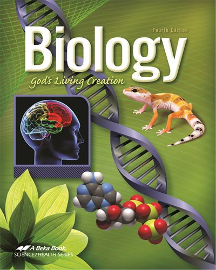Biology: God’s Living Creation differs from most other biology courses, but it is a very practical choice for homeschoolers who want to study biology from a Christian point of view.
This textbook is unusual in that it proceeds from the whole to the part, the opposite of other texts. For instance, botany study begins with types of trees and plants, moves on to parts of stems and flowers, then teaches cellular structure. In contrast, most other texts begin with cellular structure and work up toward complete organisms. The positive side of this textbook's approach is that students are more likely to find entire organisms interesting, and they might then want to learn more about the details. On the other hand, it might be problematic since understanding structures is often crucial to understanding larger organisms.
The textbook features plenty of full-color illustrations and includes two clear plastic pages that show the interior organs of the human body in an overlaid fashion.
The course is laid out in five units with a number of chapters in each unit. The first unit is on botany. The second is on human anatomy and physiology. The third unit, which is about the methods and philosophies of the life sciences, discusses the nature of scientific investigations, evolution (treated as a retreat from science), and ecology. The fourth unit is on zoology, and the fifth is on cellular and molecular biology.
Each of the 24 chapters is further subdivided into topical sections, and each section concludes with a set of Section Review questions and activities. You might find up to five different types of questions and activities in the Section Reviews. All of these sets begin with some comprehension questions. Then there are usually three or four types of other questions and activities labeled as Critical Thinking, Identify, Observe, and Application. Critical Thinking presents complex questions. Identify requires students to write out definitions for a list of terms. Observe might have students observe living creatures, and occasionally it has them collect them or make drawings. (One Observe activity has students create a small terrarium to house a small lizard.) Application questions often go beyond the comprehension level to require analytical thinking, and they sometimes require lengthy answers.
At the end of each chapter, a Chapter Review has terms to define, phrases to identify (i.e., identify “the three largest snakes” and “the longest-lived animal” on page 387), and two sets of questions labeled as Explain and Apply.
Within the chapters, special topics are addressed in articles that appear in call-out boxes labeled “Understanding the Living Creation” and “Design in the Living Creation.” The latter type of article stresses God’s hand in creation.
You have two ways to get answer keys for the textbook questions. The less-expensive Biology Answer Key has only the answers to section and chapter questions. The Biology: Teacher Edition has the entire student text followed by teaching information and lesson plans with answer keys. The lesson plans make it easier to keep track of lab work and student assignments. However, you can teach this course without the teacher edition.
This course has both a book of quizzes and a book of tests, and both of them have their own answer keys.
Lab Work
The Biology: Field and Laboratory Manual provides instruction for 25 labs that include dissections and the use of a microscope. There are also three projects involving trees, insects, and ponds. Home Science Tools sells a lab kit for this course although it does not include a microscope. The Biology Lab Demonstrations DVD shows all of the lab work and might be a solution for situations where you don’t want students to actually perform the lab work. Students who watch the DVDs still need to complete the lab manual. Gathering with a group to do lab work and sharing the cost of the resources might be the most practical solution.
Summary
Biology: God’s Living Creation should serve well for those looking for a Christian biology course written at a moderate level of difficulty.








